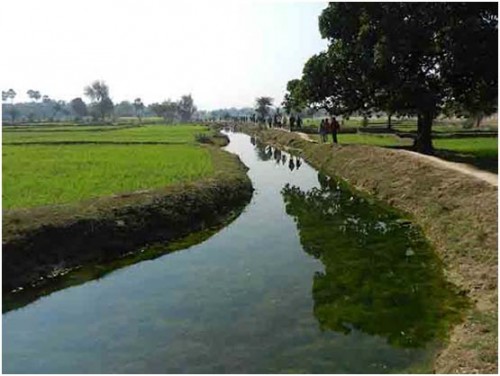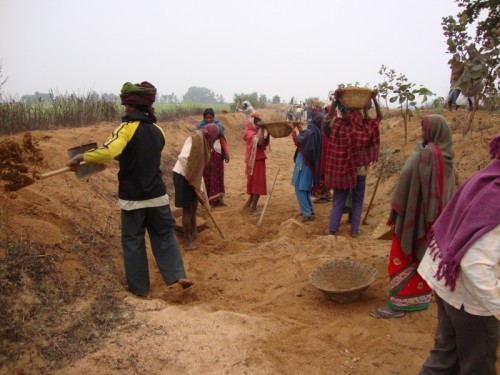TBI Videos: Magadh Jal Jamaat Helps Revive 2000-year old Flood Water Harvesting Systems in Gaya, Bihar
Magadh Jal Jamaat, a loose network of progressive individuals in Gaya has been successfully able to revive over a dozen abandoned water sources and have instilled in people the need to create, clean up and conserve several lakes and ponds in the region. The problem of water scarcity had been of late afflicting the region, which once had a good system of ponds. But through their efforts, the group has managed to revive the traditional methods of irrigation, which are now more effective than the largest irrigation system in the area.

Magadh Jal Jamaat, a loose network of progressive individuals in Gaya has been successfully able to revive over a dozen abandoned water sources and have instilled in people the need to create, clean up and conserve several lakes and ponds in the region. The problem of water scarcity had been of late afflicting the region, which once had a good system of ponds. But through their efforts, the group has managed to revive the traditional methods of irrigation, which are now more effective than the largest irrigation system in the area. Here we present two videos, created by Magadh Jal Jamaat and sourced from India Water Portal, which explain how they achieved these inspiring results, along with the transcript
Magadh is centrally located in the present area of South Bihar. Its southern part is undulated and rocky while the northern part comprises of plains. There are plains ensconced within the undulated areas too where good agriculture has prevailed through the millennia. An elaborate network of ‘ahar pynes’ (traditional water harvesting systems) have provided irrigation to the region, which was able to support the ancient Nalanda University and feed over fifty-two water bodies in the area, which is constantly swarming with pilgrims.
“Apna Pani – Apni Pahal” – A film on Magadh Jal Jamaat’s work on reviving the ahar pyne systems in Gaya, Bihar – Part I
The area receives an annual average precipitation of over 1100 mm, most of which falls during the monsoon months from June to September. Drawing upon centuries of experience, people built ‘ahar pyne’ systems, to divert the floodwaters through ‘pynes’ and stored them in ‘ahars’. Ahars are reservoirs with embankments on three sides and are built at the end of drainage lines such as rivulets or artificial works like pynes. Pynes are diversion channels led off from the river for irrigation purposes and for impounding water in the ahars.
It is mostly to the credit of these systems that paddy cultivation has been possible in this otherwise relatively low rainfall area, when compared to North Bihar. The system attained its highest development in the district of Gaya.

While the state had a role to play in the construction of the systems they were largely managed by the people in a collective mode. Modern development brought in hand pumps for drinking water purposes but very soon the decline of the aquifer led to them going defunct. The ahar pyne embankments got dilapidated, pynes became conduits of waste water and ponds became the new dumping grounds for solid wastes.
Rivers became big sewer lines and their beds were encroached for real estate purposes. The lakes meant for pilgrimage too got fouled and their water was no longer of bathing quality. Dug wells that brought up the water with diesel-powered pumps started drying up and the supply of their water for the kharif season crop declined. The land could no longer support the families who lived on it, and this led to widespread migration. People got ever more alienated from community institutions which became weaker. They did not have time for community work such as maintaining ahar pynes, a final blow that rendered the systems defunct.
It is against this background that Magadh Jal Jamaat scripted a unique success story when they revived the Saryu talaab in 2006 and later on the Jamune Dasain in Gaya city with the help of Army Service Corps Gaya, Central Reserve Police Force (CRPF), police officials, professors, students, doctors and farmers. The revival of this pond set in motion a surge of constructive forces in the region and soon the effects ping-ponged into the revival of ahar pynes. Around seventeen panchayats benefited from the revival of the 28 km long Chapardha pyne, which carries greater discharge than the Son canal, the main public irrigation system in the area.
“Apna Pani – Apni Pahal” – A film on Magadh Jal Jamaat’s work on reviving the ahar pyne systems in Gaya, Bihar – Part II
Attempts have been made to privatise the traditional irrigation systems during the period 1997-2008 and the Magadh Jal Jamaat has been creating awareness about the consequences of this and the need to successfully restore the systems on a collective basis. While the state has been creating grounds for bringing in new policy and legal framework, the group has formulated a Water Policy for the Magadh region based on wide consultations.
Magadh Jal Jamaat came up with a booklet titled “Gaya shahar ki jal vyavastha: Samasya evam samadhan”, (Water Management in the city of Gaya: Problem and Solution) which attempts to deepen the understanding of the city’s physiography, hydro-geology, present status of water availability, its potential and based on these suggests water management measures that should be taken. It notes that the city when compared to places in Punjab and Gujarat is better endowed in terms of water availability but has highly inadequate water storage and distribution mechanism. The crisis according to Ravindra Pathak, Magadh Jal Jamaat is man-made and the problem has been plaguing the city in the drought years of 2006 and 2010.

While the State Government had rights over the water, the Bihar Irrigation Act of 1997 delegated the Collector with the authority to engage any agency to repair or construct the water systems whenever it is unable to do so on its own and this is one point which MJJ has utilised. In this locale, where agriculture is increasingly becoming unviable and irrigation costly, MJJ has created a momentum by focusing on smaller barrages on streams and calling for renovation of the system through regular removal of sand through reviving collective means like the traditional system of ‘gomam’ (community labour), which had till some time ago seemed to have been washed away with the top soil.
They are actively working in close collaboration with the State Government to facilitate the creation of community based organizations for undertaking large-scale ahar-pyne renovation programme in the area. Ravindra Pathak notes that “so far the group has revived over a dozen abandoned water sources including Saryu talab in Gaya and has created several new ones”. We wish the group many successes, and hope others will join in their efforts or create similar groups in their own communities to fight the looming issue of water scarcity.
This story made me
- 97
- 121
- 89
- 167
Tell Us More
We bring stories straight from the heart of India, to inspire millions and create a wave of impact. Our positive movement is growing bigger everyday, and we would love for you to join it.
Please contribute whatever you can, every little penny helps our team in bringing you more stories that support dreams and spread hope.



















